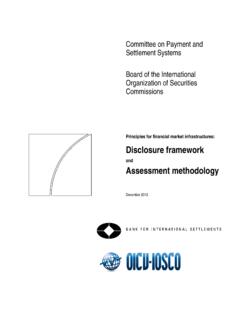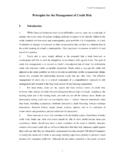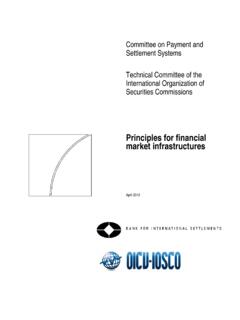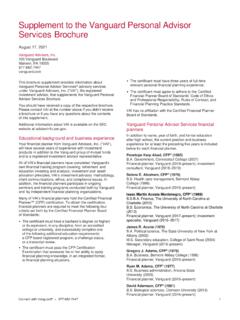Transcription of Principles for the Management of Credit Risk
1 Principles for theManagement of Credit RiskBasel Committee on Banking SupervisionBaselSeptember 2000 Risk Management Groupof the Basel Committee on Banking SupervisionChairman:Mr Roger Cole Federal Reserve Board, Washington, Nationale de Belgique, BrusselsMs Ann-Sophie DupontCommission Bancaire et Financi re, BrusselsMr Jos MeulemanOffice of the Superintendent of financial Institutions, OttawaMs Aina LiepinsCommission Bancaire, ParisMr Olivier PratoDeutsche Bundesbank, Frankfurt am MainMs Magdalene HeidBundesaufsichtsamt f r das Kreditwesen, BerlinMr Uwe NeumannBanca d Italia, RomeMr Sebastiano LaviolaBank of Japan, TokyoMr Toshihiko MoriFinancial Services Agency, TokyoMr Takushi FujimotoMr Satoshi MorinagaCommission de Surveillance du Secteur Financier,LuxembourgMr Davy ReinardDe Nederlandsche Bank, AmsterdamMr Klaas KnotFinansinspektionen, StockholmMr Jan HedquistSveriges Riksbank, StockholmMs Camilla FereniusEidgen ssiche Bankenkommission, BernMr Martin SprengerFinancial Services Authority, LondonMr Jeremy QuickMr Michael StephensonBank of England.
2 LondonMs Alison EmblowFederal Deposit Insurance Corporation, Washington, Mark SchmidtFederal Reserve Bank of New YorkMr Stefan WalterFederal Reserve Board, Washington, David ElkesOffice of the Comptroller of the Currency, Washington, Kevin BaileyEuropean Central Bank, Frankfurt am MainMr Panagiotis StrouzasEuropean Commission, BrusselsMr Michel MartinoSecretariat of the Basel Committee on Banking Supervision,Bank for International SettlementsMr Ralph NashMr Guillermo RodriguezGarciaiTable of 1 Principles FOR THE ASSESSMENT OF BANKS Management OF Credit RISK .. AN APPROPRIATE Credit RISK ENVIRONMENT .. UNDER A SOUND Credit GRANTING PROCESS .. AN APPROPRIATE Credit ADMINISTRATION, MEASUREMENT ANDMONITORING PROCESS .. ADEQUATE CONTROLS OVER Credit RISK .. ROLE OF 19 APPENDIX: COMMON SOURCES OF MAJOR Credit PROBLEMS .. 211 Principles for the Management of Credit financial institutions have faced difficulties over the years for a multitude ofreasons, the major cause of serious banking problems continues to be directly related to laxcredit standards for borrowers and counterparties, poor portfolio risk Management , or a lackof attention to changes in economic or other circumstances that can lead to a deterioration inthe Credit standing of a bank s counterparties.
3 This experience is common in both G-10 andnon-G-10 risk is most simply defined as the potential that a bank borrower orcounterparty will fail to meet its obligations in accordance with agreed terms. The goal ofcredit risk Management is to maximise a bank s risk-adjusted rate of return by maintainingcredit risk exposure within acceptable parameters. Banks need to manage the Credit riskinherent in the entire portfolio as well as the risk in individual credits or transactions. Banksshould also consider the relationships between Credit risk and other risks. The effectivemanagement of Credit risk is a critical component of a comprehensive approach to riskmanagement and essential to the long-term success of any banking most banks, loans are the largest and most obvious source of Credit risk;however, other sources of Credit risk exist throughout the activities of a bank, including in thebanking book and in the trading book, and both on and off the balance sheet.
4 Banks areincreasingly facing Credit risk (or counterparty risk) in various financial instruments otherthan loans, including acceptances, interbank transactions, trade financing, foreign exchangetransactions, financial futures, swaps, bonds, equities, options, and in the extension ofcommitments and guarantees, and the settlement of exposure to Credit risk continues to be the leading source of problems in banksworld-wide, banks and their supervisors should be able to draw useful lessons from pastexperiences. Banks should now have a keen awareness of the need to identify, measure,monitor and control Credit risk as well as to determine that they hold adequate capital againstthese risks and that they are adequately compensated for risks incurred. The Basel Committeeis issuing this document in order to encourage banking supervisors globally to promote soundpractices for managing Credit risk.
5 Although the Principles contained in this paper are mostclearly applicable to the business of lending, they should be applied to all activities wherecredit risk is sound practices set out in this document specifically address the following areas:(i) establishing an appropriate Credit risk environment; (ii) operating under a sound Credit -granting process; (iii) maintaining an appropriate Credit administration, measurement andmonitoring process; and (iv) ensuring adequate controls over Credit risk. Although specificcredit risk Management practices may differ among banks depending upon the nature andcomplexity of their Credit activities, a comprehensive Credit risk Management program willaddress these four areas. These practices should also be applied in conjunction with soundpractices related to the assessment of asset quality, the adequacy of provisions and reserves,2and the disclosure of Credit risk, all of which have been addressed in other recent BaselCommittee the exact approach chosen by individual supervisors will depend on a host offactors, including their on-site and off-site supervisory techniques and the degree to whichexternal auditors are also used in the supervisory function, all members of the BaselCommittee agree that the Principles set out in this paper should be used in evaluating abank s Credit risk Management system.
6 Supervisory expectations for the Credit riskmanagement approach used by individual banks should be commensurate with the scope andsophistication of the bank s activities. For smaller or less sophisticated banks, supervisorsneed to determine that the Credit risk Management approach used is sufficient for theiractivities and that they have instilled sufficient risk-return discipline in their Credit riskmanagement processes. The Committee stipulates in Sections II to VI of the paper, principlesfor banking supervisory authorities to apply in assessing bank s Credit risk managementsystems. In addition, the appendix provides an overview of Credit problems commonly seenby further particular instance of Credit risk relates to the process of settling financialtransactions. If one side of a transaction is settled but the other fails, a loss may be incurredthat is equal to the principal amount of the transaction.
7 Even if one party is simply late insettling, then the other party may incur a loss relating to missed investment risk ( the risk that the completion or settlement of a financial transaction willfail to take place as expected) thus includes elements of liquidity, market, operational andreputational risk as well as Credit risk. The level of risk is determined by the particulararrangements for settlement. Factors in such arrangements that have a bearing on Credit riskinclude: the timing of the exchange of value; payment/settlement finality; and the role ofintermediaries and clearing paper was originally published for consultation in July 1999. The Committee isgrateful to the central banks, supervisory authorities, banking associations, and institutionsthat provided comments. These comments have informed the production of this final versionof the in particular Sound Practices for Loan Accounting and Disclosure (July 1999) and Best Practices for Credit RiskDisclosure (September 2000).
8 2 See in particular Supervisory Guidance for Managing Settlement Risk in Foreign Exchange Transactions (September2000), in which the annotated bibliography (annex 3) provides a list of publications related to various settlement for the Assessment of Banks Management of Credit an appropriate Credit risk environmentPrinciple 1: The board of directors should have responsibility for approving andperiodically (at least annually) reviewing the Credit risk strategy and significant creditrisk policies of the bank. The strategy should reflect the bank s tolerance for risk andthe level of profitability the bank expects to achieve for incurring various Credit 2: Senior Management should have responsibility for implementing the creditrisk strategy approved by the board of directors and for developing policies andprocedures for identifying, measuring, monitoring and controlling Credit risk.
9 Suchpolicies and procedures should address Credit risk in all of the bank s activities and atboth the individual Credit and portfolio 3: Banks should identify and manage Credit risk inherent in all products andactivities. Banks should ensure that the risks of products and activities new to them aresubject to adequate risk Management procedures and controls before being introducedor undertaken, and approved in advance by the board of directors or its under a sound Credit granting processPrinciple 4: Banks must operate within sound, well-defined Credit -granting criteria should include a clear indication of the bank s target market and athorough understanding of the borrower or counterparty, as well as the purpose andstructure of the Credit , and its source of 5: Banks should establish overall Credit limits at the level of individualborrowers and counterparties, and groups of connected counterparties that aggregate ina comparable and meaningful manner different types of exposures, both in the bankingand trading book and on and off the balance 6.
10 Banks should have a clearly-established process in place for approving newcredits as well as the amendment, renewal and re-financing of existing 7: All extensions of Credit must be made on an arm s-length basis. Inparticular, credits to related companies and individuals must be authorised on anexception basis, monitored with particular care and other appropriate steps taken tocontrol or mitigate the risks of non-arm s length an appropriate Credit administration, measurement andmonitoring processPrinciple 8: Banks should have in place a system for the ongoing administration of theirvarious Credit risk-bearing 9: Banks must have in place a system for monitoring the condition ofindividual credits, including determining the adequacy of provisions and 10: Banks are encouraged to develop and utilise an internal risk rating systemin managing Credit risk. The rating system should be consistent with the nature, size andcomplexity of a bank s 11: Banks must have information systems and analytical techniques thatenable Management to measure the Credit risk inherent in all on- and off-balance sheetactivities.
















